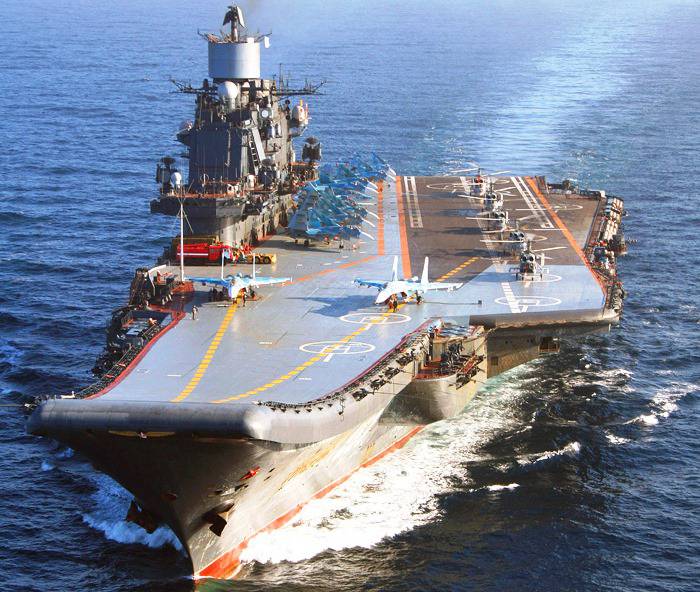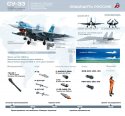You are using an out of date browser. It may not display this or other websites correctly.
You should upgrade or use an alternative browser.
You should upgrade or use an alternative browser.
Aircraft Carriers III
- Thread starter Jeff Head
- Start date
Yes, that one wth 12 Mig-29Ks on deck is the most we have seen.
It was posted some time ago on this Carrier II Thread and on the Indian Military thread as well I believe.
Russian time  much details !
much details !
The Admiral Kuznetsov: how many divisions ?
Russian Defense Minister Sergei Shoigu announced that the only Russian aircraft carrier, Admiral Kouznestov, would be deployed in the fall in the eastern Mediterranean as part of the Russian naval detachment that is constantly evolving there. At this announcement has been added that of the commander of the Russian air forces, Major General Igor Kojin, who confirmed that the PA would be endowed with all his air group. These statements raise a number of questions, particularly in view of combat missions in which PA and his group should be involved in Syria.
Renewed air group
The last deployment of PA Admiral Kuznetsov in the Mediterranean dates back to 2013/2014. The "Kouze" was then completed his seventh mission in the Mediterranean, between 17 December 2013 and 5 May 2014, thus respecting the frequency of its previous cruises in the "warm waters", which generally occur between December of the year n, and the spring of the year n + 1 (except the 2nd and 3rd mission, but they did not include deployment in the Mediterranean). After his last mission, the PA has begun a maintenance cycle to dock at the ship repair plant No. 82 (Murmansk) in May 2015 and between April and May 2016, he completed a phase of technical preparation for 'ship repair plant No. 35 (Murmansk). As indicated by TASS, the eighth deployment of the Admiral Kuznetsov should intervene between October 2016 and January 2017 - as we mentioned on this blog since last summer - and hustling habits of previous calendars.
The naval group that should take the "Kouze" - presented by the authorities as being "complete" - could include 10 Su-33 and 4 MiG-29K (v therefore car) as well as Ka-52K helicopters in originally designed to be deployed on PCBs. The Su-33 has been optimized in recent years for air superiority and protect the naval group missions. They have also been given the Gefest target designation system SVP-24 used in particular in Syria for targeting gravitational bombs. The MiG-29K multirole aircraft are 4th generation called to live as part of this output combat missions in Syria. This is a turning point in many ways: to date, the Russian PA and his group were at the Sea-Air break while having the capacity to conduct anti-surface missions (sea-sea ) and anti-air (air to air). The MiG-29K could implement precision guided munitions KAB-500 type for hitting ground targets, as well as anti-ship missiles Kh-35. The first landing of a MiG-29K on the PA has thus held on August 8. It is also expected that the Ka-52K helicopters are involved in fire support missions in Syria: the deck-landing trials were conducted for their part end in August 2016 on the "Kouze" (see photo at the end item).
What the Kuznetsov you will he able to Syria?
Originally, it was expected that the PA has a completely new air group, with MiG-29K and MiG-29KUB (two-seater). A new course was created for this purpose, the 100th regiment of autonomous aerial hunting of naval aviation. However, the announcement of maintaining the Su-33 confirms that both teams cooexisteront the PA; the above named, and the 279th Regiment (Su-33). It mostly confirms that the preparation of the group will not be completed in time.
To date, doubts remain about the carrying capacity of the MiG-29K. The PA has a springboard, not a catapult, which significantly reduces the payload carried by the Su-33 and MiG-29K. How MiG will they be able to take off with their missiles staffing? It's a mystery ... and a state secret. No photo or video shows the MiG-29K take off with their weapons, including when tested in Yeysk and Crimea (Saki) for crew qualification (see video below). This technical challenges tend to give the experience and training of drivers even more important than it already is. Or, again, there is doubt, as the deadline seem tight, and will - if not hurry - the policy to deploy the PA in the Levant has certainly put additional pressure during the training and qualification crews. The 100th regiment has been created in December 2015, there is less than a year, and has 24 MiG-29K / KUB, of which only four could actually embark on PA. Originally, the Naval wanted the MiG-29K / KUB undergo a test cycle until 2018, but the pilot training have actually started on some devices on terrestrial simulators before the end of these phases tests. The first landings "on the ground" and have started in spring 2016, and the first landing on the PA took place in early August, as previously reported. This means that pilots have at most four months (not that we obviously know the flight hours), between May and August, to practice and understand a new device: it seems very little, especially if it is to make ground strikes in Syria from the AP. This type of exercise does it seem you were not simulated during maneuvers that Kouznestov makes for some days in the Barents Sea with the nuclear cruiser Peter the Great in particular. Uncertainties therefore concern both the preparedness of the crews - including and especially the formation of new elements - as well as the ability of drivers to maneuver a camera with her arms staffing on a PA for combat missions a new type. As such, we can not exclude the deployment of PA is pushed back to December so that pilots can train some more, until the polar night forced him "Kouze" to sail for the Levant .
Beyond the aspects related to the building, Russian aircraft evolve in an air environment under the control of the Russians (S-400 detachment and air forces based in Hmeimim) - unless the Turks decide to redo about them - it which at least raises an additional difficulty.
PA Admiral Kuznetsov put far out of sanctuary zones missions and presence in the world ocean ( "hoist the flag"). It should now be able to add to his bow power projection and attack missions. However, there remains to this day serious doubts about the readiness of crews and the carrying capacity of the devices, as combat missions planned on the "Syrian polygon" should confirm or deny by the end of the year . The PA should its return to base to get in refit.
Yep, I predict the Russian Naval Aviators will miss the leggy, powerful Su-33, the Mig 29-K will be new with better avionics, but its simply not the airplane the Naval Flanker is in my own humble opinion.
I think interesting this comparison for fighters embarked especialy for area occupied,
We can see mainly :
- In general with folded the aircraft occupies a lower surface of a 1/3 except Russians/Chines about 50 %
- All have an occupied surface with folded wings enough close except Super Hornet a little more big
- Rafale only with no folded wings occupied always the same surface
- Hornet and F-35C occupied same surface with folded wings and Super Hornet clearly more than F-35C +20/25 %
- Su-33/J-15 despite it is the more large with folded wings occupied same surface than Western

We can see mainly :
- In general with folded the aircraft occupies a lower surface of a 1/3 except Russians/Chines about 50 %
- All have an occupied surface with folded wings enough close except Super Hornet a little more big
- Rafale only with no folded wings occupied always the same surface
- Hornet and F-35C occupied same surface with folded wings and Super Hornet clearly more than F-35C +20/25 %
- Su-33/J-15 despite it is the more large with folded wings occupied same surface than Western

Jura The idiot
General
... now I read in Twitter she should be off Syria in mid-October:Russian time...

Soon, there will be three of this Kuznetsov class plowing the seas. The Russian Kuzonetsov, the Chinese Liaoning, CV-16, and the Chinese CV-17.... now I read in Twitter she should be off Syria in mid-October:

Outside of US carriers, I am trying to remember when the last time that any nation had a class of large carriers that had more than two ships in it?
The French Clemenceau was a class of two.
I will not count the UKs Invincible class because they, IMHO, were not full fledged, large carriers...same with the Kiev class for the Russians.
No, outside of US carrier classes, in fact I do not think there has been a class of fleet carriers built by any nation that amounted to more than two carriers since world War II.
Now we have the Kuznetsov class of three, two of which are Chinese.
I believe there will only be two 002 CATOBAR carriers.
So we may have to wait until the Chinese 003 class to get more than two again, outside of these three.
Now, the Indians will ultimately have three carriers...the Vikramaditya (former Kiew Class) the Virkant (an indigenous Indian STOBAR carrier) and the 3rd will be the Vsshal, a medium sized, indigenous Indian CATOBAR carrier...but that will be three separate classes of one carrier each.
@FORBIN @bd popeye @tphuang @TheNavigator Now 14 Mig-29Ks seen here on the Vikramaditya flight deck at once:







